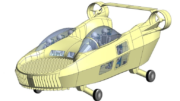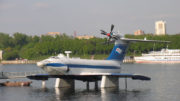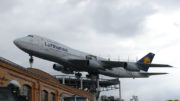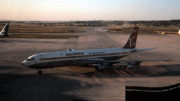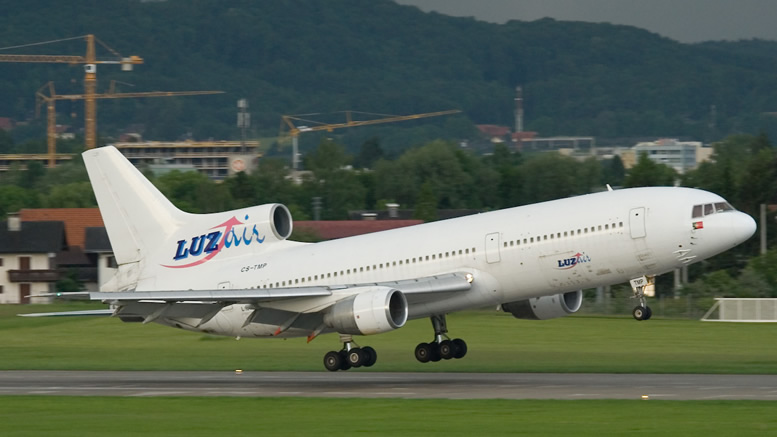 Today Lockheed is best known as one part of the aerospace company behind popular military aircraft like the Hercules, Orion, Galaxy and fighters like the F22. In the post-war era, Lockheed’s Constellation and Super Constellation series of four propeller aircraft changed the way we get around. The first plane with a pressurised cabin let it fly high above bad weather and faster. Its production as military transport during the war, meant that passenger versions were released quicker than the competition, giving Lockheed a considerable advantage at first, but eventually lost market share to Douglass. A follow-up to the Constellation, the Electra, was a sales disaster after problems with the engine mounts caused two crashes. Thanks to this and the incoming jet age, Lockheed’s passenger line of aircraft was coming to an end by the start of the 1960s, so their next project had to be better than anything else to re-enter the civilian market successfully.
Today Lockheed is best known as one part of the aerospace company behind popular military aircraft like the Hercules, Orion, Galaxy and fighters like the F22. In the post-war era, Lockheed’s Constellation and Super Constellation series of four propeller aircraft changed the way we get around. The first plane with a pressurised cabin let it fly high above bad weather and faster. Its production as military transport during the war, meant that passenger versions were released quicker than the competition, giving Lockheed a considerable advantage at first, but eventually lost market share to Douglass. A follow-up to the Constellation, the Electra, was a sales disaster after problems with the engine mounts caused two crashes. Thanks to this and the incoming jet age, Lockheed’s passenger line of aircraft was coming to an end by the start of the 1960s, so their next project had to be better than anything else to re-enter the civilian market successfully.
In the mid 1960s the three major aircraft manufacturers, Lockheed, Douglas and Boeing were approached by American Airlines looking for a new wide body plane that was smaller than the upcoming 747 and more efficient. Boeing had their hands full with the 747 and 737 projects, which left just Douglas and Lockheed in the race to come up with a response.
Both companies presented a similar dimensioned design, a wide body tri jet capable of 250 plus passengers, Douglass’s DC10 was largely based on their previous work with the DC8 while Lockheed was to develop an all new jet dubbed the L-1011 Tristar. Initially Lockheed envisioned a twin jet design, but a FAA rule not allowing twin jets past 60 mins from an airport meant a twin jet would not sell well in the USA, so a third engine placed in the rear of the fuselage fed by an S duct was chosen as the final layout. Rolls-Royce of the UK were chosen as the only engine supplier, as their upcoming RB211 jet would be the perfect size for the third engine.
In order to win sales, Lockheed chose to innovate over what the other manufacturers offered. The autopilot system was so advanced the L-1011 could land itself, something Lockheed hoped would sway North American airlines, who previously had to divert planes in bad weather. Another innovative feature was the option of either a lower deck lounge or galley. Most L-1011 examples sold featured this galley forward of the wings, accessible by two lifts to the main deck. Moving the galley and the drink carts to below freed up space for more seating on the main deck, although this came at the expense of cargo space. Later models could be optioned without this galley for extra cargo. At least two examples were optioned with the lower deck lounge. Sold to PSA, the lounge took up the galley and forward cargo area and featured an external door with built-in stairs. The idea was the airline could use the lower deck as a boarding area at less developed airports and as a premium lounge in flight. Shelving was also in this area for oversized hand luggage.
Onboard, the L-1011 was enjoyed by passengers and crew alike. Featuring wide aisles, an airy cabin thanks to no central storage bins and a 2 4 2 layout, the centre rows of four seats were divided by a small coat cabinet, the idea being you were only one seat away from an aisle at worst. Later in the L-1011s life, many airlines altered this layout, squeezing a fifth seat into the centre row.
Launch of L-1011 was hampered by a series of delays with not only the highly advanced design but also the financial problems of engine supplier Rolls-Royce, who were eventually bailed out by the UK government. These delays pushed many airlines to purchase the competing Douglas DC10, which launched a year earlier, despite development starting at the same time as the L-1011. Douglas also had a track record of producing jet passenger aircraft which many airlines already owned, so it was easier to go with what you knew rather than choose the new Lockheed model. While the advanced features and excellent safety record were enjoyed by some, they were not compelling enough to turn the L-1011 into a runaway sales success.
Eventually, 250 L-1011s were produced from 1968, well short of the 500 required to break even. Several different variants were produced over the production run including a shorter version with a longer range version and more powerful engines, dubbed the L-1011-500, it entered service in 1979 and was the last variant to be produced in 1984. The relaxation of the 60-min rule to twin jets in the late 70s and early 80s saw the increase of popularity of similar sized twin jets like the Airbus A300 and Boeing 767, this and the financial struggles of Lockheed saw the end of Lockheed’s commercial aircraft production. Had the L-1011 been more successful other Lockheed jets based on the L-1011 technology could have been produced including the twin jet version they always wanted to build.
The last commercially operating L-1011s were withdrawn from service in 2008, the British RAF used six ex British Airways and three ex Pan Am aircraft as aerial refuellers from 1984 to 2014. As of 2022 one l-1011 is currently still airworthy and in use by Northrop Grumman as an aerial launch pad for a variety of test rockets. Today, a dozen Tristars remain on display at various aircraft museums around the world with most of the remaining examples already scrapped. Lockheed merged with Martin Marietta in 1995 and are now focused on aerospace and defence products, the L-1011 Tristar was the last commercial aircraft produced by the company.
By: Gary Watts

